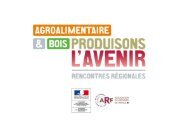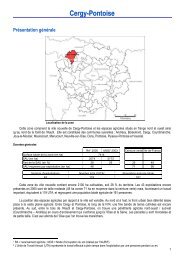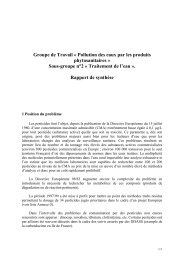Redaction_ apres_COREAMR - DRIAAF Ile-de-France - Ministère ...
Redaction_ apres_COREAMR - DRIAAF Ile-de-France - Ministère ...
Redaction_ apres_COREAMR - DRIAAF Ile-de-France - Ministère ...
You also want an ePaper? Increase the reach of your titles
YUMPU automatically turns print PDFs into web optimized ePapers that Google loves.
Figure 61 : Raisons d’acheter <strong>de</strong>s produits <strong>de</strong> consommation<br />
(Source CREDOC Enquête Consommation 2011)<br />
Si on prend le cas particulier <strong>de</strong>s AMAP (qui reste toutefois un cas assez marginal par rapport aux quantités <strong>de</strong><br />
produits locaux commercialisés), on note une forte augmentation ces <strong>de</strong>rnières années du nombre <strong>de</strong> ces<br />
structures, témoignant aussi d’une augmentation <strong>de</strong> la <strong>de</strong>man<strong>de</strong> en produits locaux. Selon le réseau AMAP <strong>Ile</strong>-<strong>de</strong>-<br />
<strong>France</strong>, 5000 familles sont aujourd’hui concernées (cf. tableau 15) :<br />
Tableau 15 : Nombre d'AMAP en Île-<strong>de</strong>-<strong>France</strong><br />
Source : AMAP <strong>Ile</strong>-<strong>de</strong>-<strong>France</strong> (site internet 2012)<br />
Leurs attentes<br />
L’enquête «Caractérisation <strong>de</strong> la <strong>de</strong>man<strong>de</strong> en produits <strong>de</strong> proximité par la restauration collective (scolaire,<br />
d'entreprises et d'État) en Île-<strong>de</strong>-<strong>France</strong>» menée par l’INRA et Tecomah avec la <strong>DRIAAF</strong> en 2010-2011 auprès <strong>de</strong><br />
la restauration collective montre que les produits locaux ne sont pas encore très populaires auprès <strong>de</strong>s convives<br />
(18,5% <strong>de</strong>s sondés relatent une <strong>de</strong>man<strong>de</strong> en produits locaux <strong>de</strong>s convives) mais on constate la nécessité d’une<br />
volonté, soit <strong>de</strong> niveau politique (élus), soit <strong>de</strong>s dirigeants (gestionnaires <strong>de</strong> cantines publics et privés) <strong>de</strong> donner<br />
cette orientation (39% <strong>de</strong>s donneurs d’ordre <strong>de</strong>man<strong>de</strong>nt du local). Pour ce qui est <strong>de</strong>s produits bio, 49% <strong>de</strong>s<br />
sondés font référence à <strong>de</strong>s <strong>de</strong>man<strong>de</strong>s <strong>de</strong> la part <strong>de</strong>s convives et 68% <strong>de</strong> la part <strong>de</strong>s donneurs d’ordre.<br />
Toutefois, comme le montre la figure ci-<strong>de</strong>ssous, la notion <strong>de</strong> produit local doit être abordée avec précaution.<br />
87
















